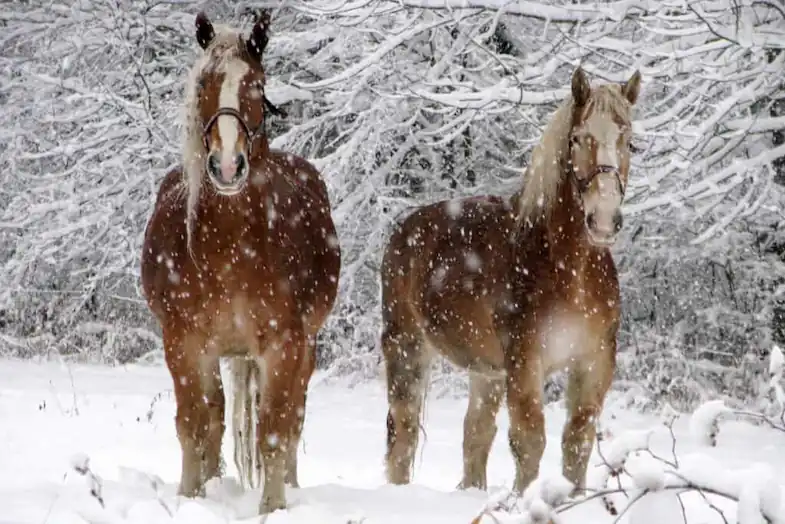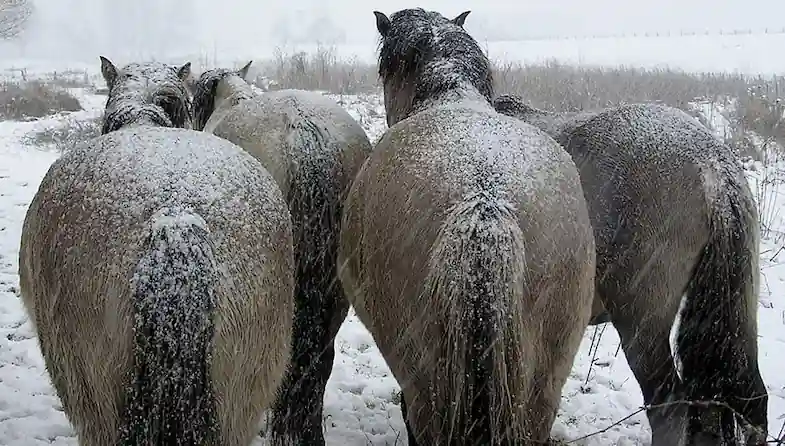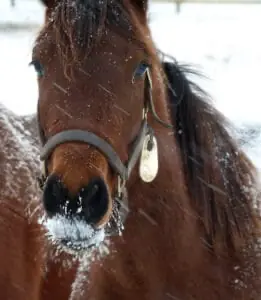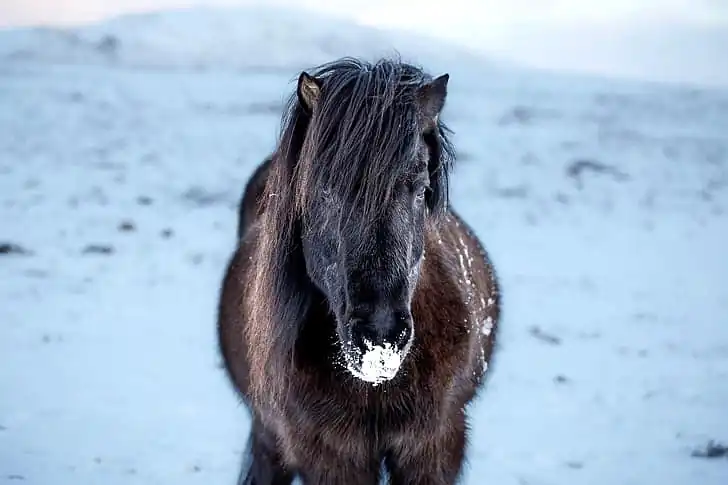With the weather being so changeable at the moment it can be difficult to know whether to turn your horse out or bring him in, or even whether to blanket him or not. All of this uncertainty means that there’s more chance of a horse getting cold, but what’s the best way to warm them up if they do get too cold?
Horses can withstand far colder temperatures than us but when their body temperature drops below 98°F (36.6°C) you need to call your veterinarian and help your horse to warm up. The quickest way to do this is to put a blanket on them and walk them around, but feeding hay will also help to warm them up.
Horses are far better at dealing with the cold than we are but that doesn’t mean to say they don’t (or won’t) suffer from the cold at all but with a little bit of careful planning, you can stop that from happening or at least help your horse to warm up again if he does get too cold.
How do you warm up a horse that’s cold?
If your horse is too cold you shouldn’t wait and hope that he warms up naturally, you need to act straight away. If your horse’s temperature is below 98°F (36.6°C) or higher than 103°F (39.4°C) you should call your veterinarian immediately. You might think that it doesn’t matter if your horse’s temperature is above normal but if they’re sweating and the weather is cold or wet then a high temperature can still mean your horse will be too cold.
Once you’ve called your veterinarian you should start to warm your horse up, whether your horse is wet or not will determine how you do this.
Warming up a cold and wet horse
- Bring your horse into a warm, dry stall that doesn’t have any drafts. This will stop him from getting any wetter or colder and will also help to warm him up a little.
- Remove as much moisture as possible with whatever towels you have. It doesn’t matter if they’re large bath towels or small dishcloths as long as they remove the moisture for your horse. You’ll also need to change the towels when they get too wet to remove any more moisture.
- Give your horse plenty of hay to eat while you’re drying him. This will help to keep him occupied and standing still while you dry him but more importantly it’ll help to warm him up from the inside.
- Once you’ve dried your horse off completely you should follow the steps below for warming up a horse that’s cold.
Warming up a cold horse
- Blankets and leg wraps will help to keep any warmth close to your horse’s body but it’s important that you don’t use too heavier blankets straightaway otherwise you run the risk of warming him up too quickly and causing him to sweat. Instead use a lightweight blanket, adding more if needed.
- If you’re able to walk your horse around then gently walk him in large circles. This will get his muscles warmed up and therefore warm his whole body up. Don’t exercise him too vigorously though otherwise, he’ll start to sweat.
- If you’re not able to walk your horse around make sure he has plenty of hay to eat and that his water is warm rather than cold. If you can, keep your horse in a warm, draft-free shelter until he’s warmed up.
How do you stop a horse from getting cold?
As they say, prevention is always better than cure and horses are no exception to that, it’s far better (and easier) to keep your horse warm than it is to warm him up when he gets cold. It can be hard though to keep your horse warm when the mercury starts to drop and there’s a snow blizzard outside but there are a few steps you can take to make sure he stays nice and warm throughout the winter.
- Feed additional hay – As your horse eats hay his digestive system will create heat (this is why we talk about ‘burning’ calories) that will help to keep him warm from the inside. This is even more important for horses that are thinner or have thin coats.
- Warm-up your horse’s feed – Just as you might have a hot bowl of porridge to warm you up in the winter, your horse will also appreciate it if you warm his feed up with a little bit of hot water when the weather’s really cold, even if it’s only his breakfast.
- Make sure the water is warm – It’s no secret that horses drink less water in the winter than they do in the summer but what you might not know though is that the reason for this is because the water is often too cold. A recent study has found that in the winter horses prefer to drink water that’s between 45° and 65°F (7° and 18°C) so if you can, use a submersible tank de-icer. They’re readily available on Amazon and will make the water more appealing to your horse.
- Provide your horse with appropriate shelter – If your horse is turned out for a long period of time you should make sure he has a shelter where he can seek refuge from the wind, rain, snow, and freezing temperatures. Regardless of whether your horse has a natural shelter or a manmade one it should offer him protection on three sides.
- Uses blankets if necessary – Not all horses need blankets (especially if the temperature is above 20°F (-7°C) but if your horse has been clipped or has a thin coat (or skin) you should use a ventilated, waterproof blanket to keep him warm. You should also remove the blanket regularly and check that your horse isn’t too hot or cold underneath it.
How do you tell if a horse is cold?
Some people insist that you can tell if a horse is cold or not by feeling their ears but this isn’t a very reliable way of gauging their temperature because of the way their bodies (and in particular their winter coats) work to keep them warm. It might sound counterintuitive but chances are if your horse’s ears are cold then he’s going to be warm. The reason for this is that his coat is working to keep the warm air in and against his body, therefore keeping your horse warm. Some horses (especially breeds native to cold countries such as the Icelandic Horse) have been known the have icicles hanging from their fur despite the fact that they’re perfectly warm and comfortable inside.
The best, and most accurate, way of telling if your horse is cold is to use a rectal thermometer (available from Amazon) to take your horse’s temperature. A horse’s normal temperature is 101.5°F (38.6°C) so anything around that is good. If your horse is below 98°F (36.6°C) though you need to call your veterinarian immediately and start to warm your horse up. It’s rare for horses to suffer from hypothermia but it’s not unheard of so don’t take any chances.
If you don’t have a rectal thermometer don’t worry, there are a few signs you can look for to tell if your horse is cold or not:
- Shivering – Just like us, horses will start to shiver if they get really cold. It can look like their muscles are spasming but it’s just the body’s natural way of trying to warm them up.
- Tail tucked in – While horses may clamp their tails tight against their bodies when they’re going to buck (or kick) or if they’re suffering from abdominal pain (such as colic) but they can also do it when they’re cold. It’s believed that they’re reducing their surface area as much as possible to keep what little heat they have in.
- Huddling – Horses are sociable animals that will often huddle together when it gets cold but if they’re doing this more than normal or are all shivering too it’s a good indication that they can’t raise their temperature enough to keep warm.
What can cause a horse to get cold?
While most horses are able to keep themselves warm during the winter if they haven’t developed a proper winter coat, for whatever reason, they’re far more likely to suffer from the cold. If your horse does have a good quality winter coat there are still a number of reasons why he might get cold during the winter.
- Not getting enough to eat – Horses will burn far more calories in the winter just trying to keep themselves warm which is why you should increase the amount of hay you feed them during the winter. As a general rule of thumb, horses need between 15-20% more calories for every 10°F (12°C) below 32°F (0°C).
- Not enough water – If your horse doesn’t have enough warm water to drink during the winter then he could start to eat the snow which will use far more energy than he’ll get from drinking it (and possibly even his food if he eats enough snow). Make sure that your horse has enough clean, fresh water to drink to prevent it from happening.
- They don’t have enough fat – Horses that are thin don’t have enough fat around them to keep them warm so are far more likely to get cold during the winter. While it can be difficult to increase your horse’s weight if he’s a hard keeper it might be advisable to use a blanket if the weather is very cold.
- Not enough movement – Moving around is one of the best ways horses (and us for that matter) keep warm which is why most horses that are kept inside during the winter are also blanketed. Try and increase your horse’s turnout if possible to help him keep himself warm.
- Sweating too much – If your horse is sweating excessively after exercise it’s important to make sure he’s completely dry before you turn him out. Doing so will restore his winter coat back to its natural state where it’s able to keep him warm.
- Wearing shoes – While you might not think that horseshoes will have any bearing on a horse’s temperature, removing them will allow his feet to expand slightly. This will increase the circulation and help to keep your horse a little bit warmer.
Related questions
When will my horse get its winter coat?
All horses are different but as a general rule, most horses will start to grow their winter coat towards the end of August (or February in the Southern Hemisphere). Just before they do this they’ll shed some of their thin summer coat to make way for the thicker and much longer winter coat.
How cold is too cold for horses to live outside?
Most horses are perfectly comfortable when the temperature is somewhere between 18° and 59°F (-8° to 15°C) although some breeds, such as the Dartmoor Pony or the Icelandic Horse can tolerate temperatures as low as -40°.
I hope you found this article helpful. If you did I’d be grateful if you could share it please as it would really help me.
Recommended products
Over the years I have tried hundreds of different horsey products, from various blankets and halters to different treats. Some I’ve loved, others I’ve hated but I thought I’d share with you my top all-time favorite products, the ones I never leave the yard without. I’ve included links to the products (which are in no particular order) that I really think are great.
- Horse Knots by Reference Ready – If you’re like me and enjoy pocket reference guides then you’ll love this knot tying guide. These handy cards can easily fit in your pocket or attach to the saddle for quick reference. They’re waterproof, durable and are color coded to make them easy to follow.
- Mane ’n Tail Detangler – Even if you never show your horse you’ll need to detangle his tail from time to time (and possibly his mane too) which is always a challenging chore! I’ve found that if I run a little bit of detangler through my horse’s tails every few days it stops them from getting matted up and makes combing them easy, even if they’re coated in mud. I don’t know if I should admit to this or not but it also works wonders on my hair.
- TAKEKIT Pro clippers – Over the years I’ve tried a lot of different clippers and while some were obviously better than others I found these to be by far the best. They are heavier than a lot of other clippers but for me, that’s a good thing, it makes them feel more sturdy and hardwearing. On top of that they have a range of speeds so are just as good for clipping your horse’s back as they are his face. I also like the fact that they come in a handy carry case but that’s not for everybody. The company that makes them is super good and incredibly helpful too, a real bonus these days. The only thing I wasn’t keen on was the fact that it doesn’t come with any oil, but that’s not a major problem as it’s not difficult to buy lubricant.
- Shire’s ball feeder – There are so many boredom buster toys out there but I like to use these every day, regardless of whether or not my horses are bored. I find that it helps to encourage my horses to problem solve by rewarding them with treats (or pieces of fruit) but it also mimics their natural grazing behavior which helps to keep them calm and de-stressed.
- Horse safe mirror – This is a strange one that many people are surprised about but I like to put horse safe mirrors in the trailers as well as in the quarantine stalls. It helps to prevent the feeling of isolation by giving the impression of other horses being around. Being herd animals horses can get extremely stressed when they feel that they’re on their own but with these stick-on mirrors, they believe that at least one other horse is with them.
- Rectal thermometer – I know this isn’t glamourous at all but it’s vital for your horse’s well-being to be able to check their temperature and a rectal thermometer is the easiest way of doing this which is why I’ve added it to the list.
Shopping lists
I’ve also put together a few shopping lists of essential items that I’ve found helpful over the years. I’ve broken the lists down into different categories rather than put everything in one massive list 😉





